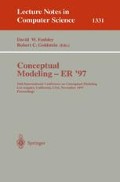Abstract
One of the most serious limitations of the Entity Relationship Model in practice is its inability to cope with complexity. With large numbers of entities, data models become difficult to understand and maintain. The problem becomes unmanageable at the enterprise level, where models typically consist of hundreds of entities. A number of approaches have been proposed in the literature to address this problem, but none have achieved widespread acceptance in practice. This paper proposes a simple and natural extension to the Entity Relationship Model which allows enterprise data models to be represented at multiple levels of abstraction, from a one page overview down to primitive entities and relationships. The model may be organised into any number of levels, depending on its complexity. The technique is based on the organisation of a city street directory, which is a practical solution to the problem of representing a large and complex model in everyday life.
Preview
Unable to display preview. Download preview PDF.
References
Allworth, S., “Using Classification Structures to Develop and Structure Generic Industry Models”, Proceedings of the First Australian Data Management Conference, Data Management Association (DAMA), Melbourne, Australia, December 2–3, 1996.
Bubenko, J.A. Information Systems Methodologies-A Research View, in Olle, T.W., Sol, H.G., Verrijn-Stuart, A.A. Information Systems Design Methodologies: Improving The Practice. North-Holland, 1986.
Carlson, C.R., Ji, W. and Arora, A.K., The Nested Entity Relationship Model, Entity Relationship Approach to Database Design and Querying, North Holland, 1990.
Codd, E.F., A Relational Database Model for Large Shared Data Banks, Communications of the ACM, 13, 6, 1971.
Date, C.J., Relational Database: Selected Writings, Addison-Wesley, 1986.
Davis, G.B. and Olsen, M.H., Management Information Systems: Conceptual Foundations, Structure and Development, McGraw-Hill, 1985.
Dawson, K.S. and Parker, L.M.P., From Entity-relationship Diagrams to Fourth Normal Form: A Pictorial Aid to Analysis, The Computer Journal, Vol. 31, No.3, 1988.
De Marco, T., Structured Analysis and System Specification, Yourdon Press, 1978.
Dumpala, S.R. and Arora, S.V., Schema translation using the Entity-Relationship Approach, In Chen, P.P. (ed.) The Entity-Relationship Approach to Information Modelling and Analysis, North-Holland, 1983.
Feldman, P. and Miller, D., Entity Model Clustering: Structuring a Data Model by Abstraction, The Computer Journal, Vol. 29, No. 4,1986.
Flood, R.L. and Carson, E.R., Dealing With Complexity: An Introduction to the Theory and Application of Systems Science, Plenum Press, 1988.
Gandhi, M., Robertson, E.L. and Van Gucht, D., Levelled Entity Relationship Model, Proceedings of the Thirteenth International Conference on the Entity Relationship Approach, Manchester, December 14–17, 1994.
Gilberg, R.F., A Schema Methodology for Large Entity-Relationship Diagrams, in Chen, P.P. (ed.) Proceedings of Fourth International Conference on the Entity Relationship Approach, 1986.
Klir, G.J., Architecture of Systems Problem Solving, Plenum Press, 1985.
Leung, C.M.R. and Nijssen, G.M. From a NIAM Conceptual Schema into the Optimal SQL Relational Database Schema, Australian Computer Journal, May, 1987.
Lipowski, Z.J., Sensory and Information Inputs Overload, Comprehensive Psychiatry, Vol. 16, 3, May/June, 1975.
Martin, J., Strategic Data Planning Methodologies, Prentice-Hall, 1983.
Miller, G., The magical number seven, plus or minus two: Some limits on our capacity for processing information, The Psychological Review, March, 1956.
Moody, D.L. and Shanks, G.G., “What Makes A Good Data Model? Evaluating the Quality of Entity Relationship Models”, Proceedings of the Thirteenth International Conference on the Entity Relationship Approach, Manchester, December 14–17, 1994.
Moody, D.L., “A Practical Methodology for the Representation of Large Data Models”, Proceedings of the Australian Database and Information Systems Conference, University of N.S.W., Sydney, Australia, February, 1991.
Moody, D.L., “Graphical Entity Relationship Models: Towards A More User Understandable Representation of Data”, Proceedings of the Fifteenth International Conference on the Entity Relationship Approach, Cottbus, Germany, October 7–9, 1996a.
Moody, D.L., and Osianlis, A., “Bringing Data Models to Life: An Interactive Tool for Representing Entity Relationship Models”, Proceedings of the Seventh Australasian Conference on Information Systems, Hobart, Australia, December 11–13, 1996.
Moriarty, T., “Where's The Business?”, Database Programming and Design, July, 1993a.
Newell A., and Simon, H.A., Human Problem Solving, Prentice-Hall, 1972.
Rescher, N., The Primacy of Practice, Blackwell, 1973.
Shanks, G.G., “Enterprise Data Architectures: A Study of Practice”, First Australian Data Management Conference, Melbourne, Australia, December 2–3, 1996.
Simon, H.A. Sciences of the Artificial, MIT Press, 1982.
Simsion, G.C, A Structured Approach to Data Modelling, The Australian Computer Journal, August, 1989.
Smith, J.M. and Smith, D.C.P., Database Abstractions: Aggregation and Generalization, ACM Transactions on Database Systems, Vol. 2 No. 2, 1977.
Sowa, J.F. Conceptual Structures: Information Processing in Mind and Machine, Prentice-Hall, 1984.
Teory, T.J., Wei, G., Bolton, D.L., and Koenig, J.A., ER Model Clustering as an Aid for User Communication and Documentation in Database Design, Communications of the ACM, August, 1989.
Teory, T.J., Yang, D. and Fry, J.P., A Logical Design Methodology For Relational Databases Using The Extended Entity Relationship Model, ACM Computing Surveys, 18, 2, 1986.
Author information
Authors and Affiliations
Editor information
Rights and permissions
Copyright information
© 1997 Springer-Verlag Berlin Heidelberg
About this paper
Cite this paper
Moody, D. (1997). A multi-level architecture for representing enterprise data models. In: Embley, D.W., Goldstein, R.C. (eds) Conceptual Modeling — ER '97. ER 1997. Lecture Notes in Computer Science, vol 1331. Springer, Berlin, Heidelberg. https://doi.org/10.1007/3-540-63699-4_16
Download citation
DOI: https://doi.org/10.1007/3-540-63699-4_16
Published:
Publisher Name: Springer, Berlin, Heidelberg
Print ISBN: 978-3-540-63699-1
Online ISBN: 978-3-540-69630-8
eBook Packages: Springer Book Archive

